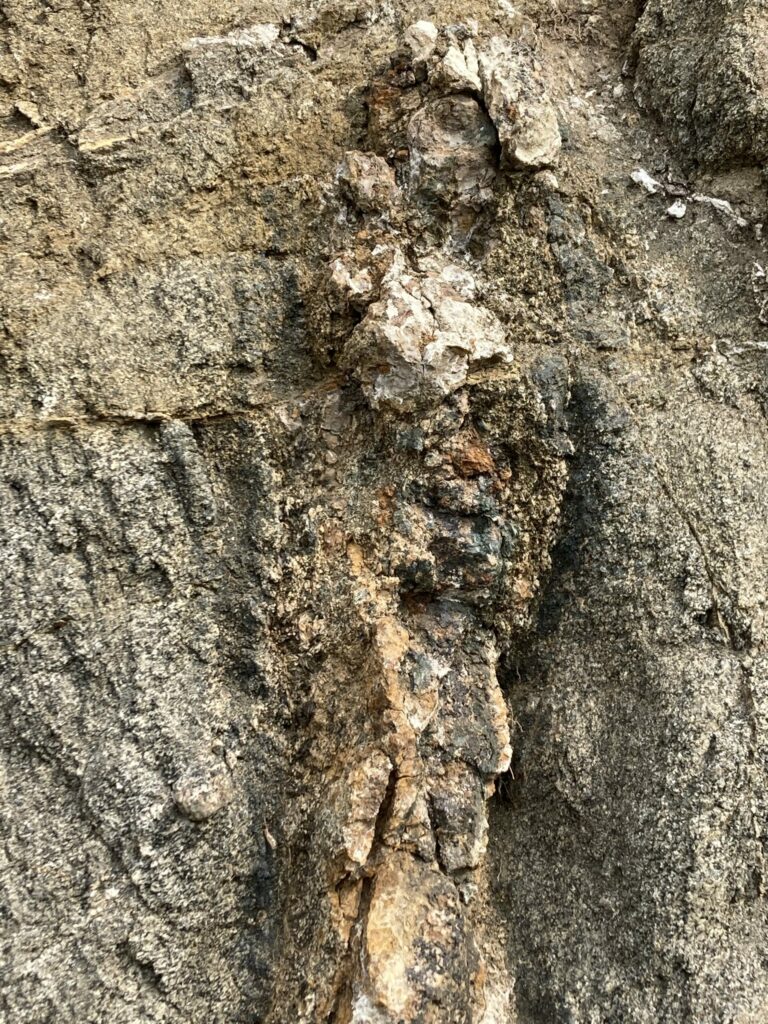Significant Mineralization Confirmed At Depth
One characteristic that sets Sheep Creek apart from most other rare earths projects in the U.S. is the fact that significant mineralization has been accessed and sampled underground via pre-existing mine workings.
US Critical Materials has recently confirmed mineralization at depth below high-grade surface samples of 17.05% TREO and 16.44% TREO. Based on the presence of mineralization at depth, the technical team intends to focus exploration efforts on these promising zones. Two of three historic adits, Adit #3 and Adit #1, have been successfully opened and sampled. Samples have been sent for analysis at Activation Laboratories, a widely recognized leader in rare earths analyses located in Ancaster, Canada. Results from opening, mapping, and sampling of the underground workings will support the filing of a Plan of Operation with the U.S. Forest Service for summer 2023 drilling.
Horizontal tunnels excavated into the hillsides (also known as “adits”) on the property provide direct access to rare-earth mineralization, and continue underground approximately 400 feet. This is an extraordinary feature among current domestic rare earths projects. These adits were tunneled-in and developed during the late 1950’s in pursuit of niobium (otherwise known as columbium), but had not been evaluated for rare-earth mineralization. These tunnels have been sealed since the 1960’s. The companies exploring or mining in that area at the time had no use for the rare earths, which were first widely used in 1964 with the technological advent of Europium applications in color television.
Today by contrast, these historic adits at the Sheep Creek property are of great benefit to US Critical Materials, as the carbonatite exposures afforded by the past underground workings greatly advance our understanding of this complex and unique geologic system. In October of 2022, US Critical Materials reopened two of these tunnels and found considerable banded carbonatite and rare-earth mineralization continuing from the same system as exposed at the surface.
The existence of accessible rare-earth mineralization in dikes and veins extending at least 125 feet below the surface is unique among existing domestic rare earths projects. To excavate and develop these adits today and replicate this type of confirmation of rare earths at that depth, a company would need a variety of permits and approvals, which in the current environment would be very difficult and expensive to obtain. Because of their historic status, the underground passages that US Critical Materials is exploring have not required these strict approvals, nor incurred the exorbitant costs which creating them would entail.
US Critical Materials is a modern-day beneficiary of historical mining and exploration activities, as the adits are “grandfathered” and do not need further permitting. Being able to confirm significant mineralization underground has placed US Critical Materials far ahead of other rare earths projects, many of which are still waiting for permits and have spent huge sums of money to find out what is below the surface of their largely low-grade deposits. The benefits in terms of cost and time are incalculable.

Sheep Creek
Provide Secure Supply
US Critical Materials Corp. intends to work with the US government and US corporations-especially auto-manufacturers, to provide a secure supply of rare earths and critical minerals.
Exploration & Development
The properties contain at least 12 of the critical risk elements as defined by the U.S. Geological Survey. The key property elements include high levels of neodymium and praseodymium.
Highest Grade
Sheep Creek is one of the highest-grade light rare earth projects in the US. Sampling has produced average TREE (total rare earth elements) of 9%
Adit #1
The carbonatite exposed in Adit #1 is up to 3 feet in width and can be followed for 270 feet along the drift. Ancylite is present throughout the underground workings. 12 rock-chip channel samples were collected from Adit #1. A grab sample of ancylite-bearing carbonatite analyzed in 2021 from a surface outcropping of the dike, about 50 feet above Adit #1 contained 16.44 % total rare-earth oxides, including: 16,563 ppm (1.66%) neodymium oxide; and 6,261 ppm (0.63%) praseodymium oxide.

Adit #3
The carbonatite exposed in Adit #3 is accessed by a crosscut approximately 400 feet long at which point it intersects a northwest-southeast trending carbonatite that is developed over approximately 120 feet. The carbonatite in the mine workings correlate to carbonatites exposed in a trench cut 125 vertical feet above the adit. The carbonatite in Adit #3 has been measured in places at over 4 feet in width and is strongly banded with ancylite, allanite and monazite. Nine rock-chip channel samples were collected from Adit #3 and measured. A grab sample of ancylite-bearing carbonatite analyzed in 2021 from the trench above the adit contained 17.05% total rare-earth oxides, including: 15,746 ppm (1.57%) neodymium oxide; and 6,249 ppm (0.62%) praseodymium oxide.
A grab sample of carbonatite from the mine dump of Adit #3 (sample 21004) contained 7.26% total rare-earth oxides, including: 8,398 ppm (0.84%) neodymium oxide; and 3,101 ppm (0.31%) praseodymium oxide.
An XRF scan of the carbonatite underground in Adit #3 showed 8.7% cerium, 6.9% lanthanum, and 2.8% strontium.
